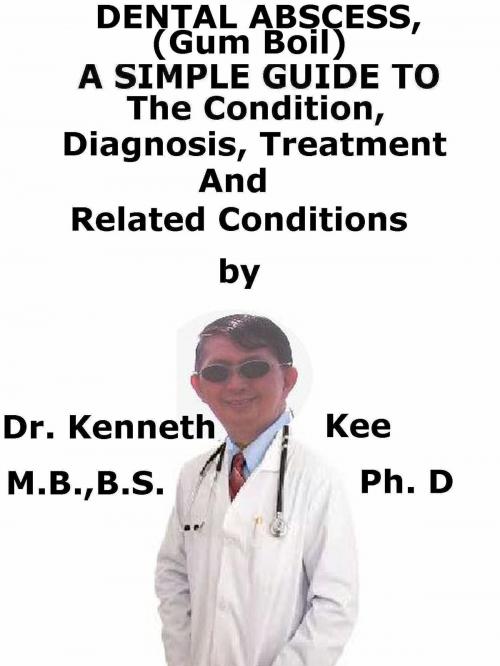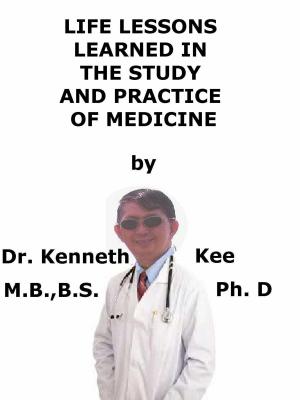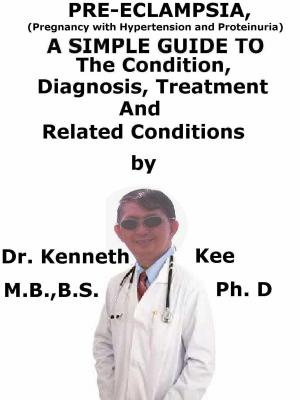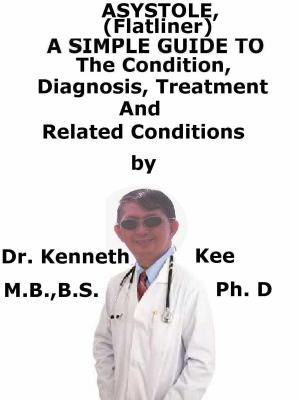Dental Abscess, (Gum Boil) A Simple Guide To The Condition, Diagnosis, Treatment And Related Conditions
Nonfiction, Health & Well Being, Medical, Dentistry, Periodontics, Health, Ailments & Diseases, Oral Health| Author: | Kenneth Kee | ISBN: | 9781370819553 |
| Publisher: | Kenneth Kee | Publication: | June 6, 2017 |
| Imprint: | Smashwords Edition | Language: | English |
| Author: | Kenneth Kee |
| ISBN: | 9781370819553 |
| Publisher: | Kenneth Kee |
| Publication: | June 6, 2017 |
| Imprint: | Smashwords Edition |
| Language: | English |
Dental abscesses or gum boils are often seen by a family doctor as a cause of pain in the mouth.
A dental abscess is a pocket of pus that can develop inside the teeth, within the gums, or inside the bone that holds the teeth in place.
It is normally caused by a bacterial infection.
1. An abscess at the end of a tooth is called a periapical abscess.
This form of abscess begins in the center of the tooth (the dental pulp).
This is the most frequent type.
This form of dental abscess normally occurs as a complication of tooth decay
The injury to the tooth permits bacteria to attack the pulp to cause an infection.
An infection in the pulp can go on to form an abscess.
2. An abscess in the gum is called a periodontal abscess.
A periodontal abscess may also form as a complication of injury to the gums or periodontium.
A periodontal abscess is occasionally called a gum boil as the abscess causes a swelling to form next to a tooth.
It most often forms as a complication of gum disease (periodontal disease), which is infection or inflammation of the tissues that enclose the teeth.
Gum disease often induces the gum to become slightly detached from the tooth.
This causes pockets to form which may get filled with bacteria and go on to form an abscess.
Eventually an abscess can induce the bone around the tooth to dissolve.
If too much bone is lost, the tooth will become loosen and may need to be removed.
These factors can raise the chances of forming a dental abscess:
1. Poor oral hygiene
2. Eating lots of sugary or starchy food and drink
3. An injury or prior surgery to the teeth or gums
4. Having a weakened immune system
5. A tooth abscess may develop if there is tooth decay.
7. It may also happen when a tooth is broken, chipped, or injured in other ways.
The main symptom is a serious toothache.
1. An intense, throbbing pain in the affected tooth or gum that may occur suddenly and gets slowly worse
2. Pain that extends to the ear, jaw and neck on the same side as the affected tooth or gum
3. Pain that is worse when lying down, which may disturb the sleep
4. Redness and swelling in the face
5. A tender, discolored and loose tooth
6. Shiny, red and swollen gums in the mouth with blood or pus oozing from it
7. Sensitivity of the teeth to hot or cold food and drink
Diagnosis is by:
Dental abscess appearance
X-rays of mouth and teeth may show the abscesses
Treatment is by:
Pain killers
Mouth rinses especially in ruptured abscess
Use of soft toothbrush
Initial treatment
A dental abscess requires treatment right away.
The dentist may:
1. Give antibiotics to kill the bacteria causing the infection.
2. Make a hole in the tooth to drain the pus and give great relief of symptoms.
3. Do a root canal to remove the infected pulp in the tooth.
4. Remove the tooth. This may be needed if a root canal treatment does not help.
For a periapical abscess
The treatment for this form of dental abscess is normally root canal treatment.
This treatment is to save and recover the injured or dead inner part of a tooth (the pulp).
The dentist will drill into the dead tooth to permit pus to escape through the tooth, and then remove the dead pulpal tissue.
A root filling is then put into the tooth to fill the space and avoid further infection.
If the infection continues despite root canal treatment, the dentist may have to remove (extract) the tooth.
For a periodontal abscess
Once the pus is drained, a dentist may clean the pocket where the abscess had developed.
After this a dentist may smooth out the root surfaces of the tooth to induce the gum to close back on to the tooth and for any pocket to fade away.
Tooth extraction is done as last resort.
TABLE OF CONTENT
Introduction
Chapter 1 Dental Abscess
Chapter 2 Causes
Chapter 3 Symptoms
Chapter 4 Diagnosis
Chapter 5 Treatment
Chapter 6 Prognosis
Chapter 7 Ludwig’s Angina
Chapter 8 Vincent’s Angina
Epilogue
Dental abscesses or gum boils are often seen by a family doctor as a cause of pain in the mouth.
A dental abscess is a pocket of pus that can develop inside the teeth, within the gums, or inside the bone that holds the teeth in place.
It is normally caused by a bacterial infection.
1. An abscess at the end of a tooth is called a periapical abscess.
This form of abscess begins in the center of the tooth (the dental pulp).
This is the most frequent type.
This form of dental abscess normally occurs as a complication of tooth decay
The injury to the tooth permits bacteria to attack the pulp to cause an infection.
An infection in the pulp can go on to form an abscess.
2. An abscess in the gum is called a periodontal abscess.
A periodontal abscess may also form as a complication of injury to the gums or periodontium.
A periodontal abscess is occasionally called a gum boil as the abscess causes a swelling to form next to a tooth.
It most often forms as a complication of gum disease (periodontal disease), which is infection or inflammation of the tissues that enclose the teeth.
Gum disease often induces the gum to become slightly detached from the tooth.
This causes pockets to form which may get filled with bacteria and go on to form an abscess.
Eventually an abscess can induce the bone around the tooth to dissolve.
If too much bone is lost, the tooth will become loosen and may need to be removed.
These factors can raise the chances of forming a dental abscess:
1. Poor oral hygiene
2. Eating lots of sugary or starchy food and drink
3. An injury or prior surgery to the teeth or gums
4. Having a weakened immune system
5. A tooth abscess may develop if there is tooth decay.
7. It may also happen when a tooth is broken, chipped, or injured in other ways.
The main symptom is a serious toothache.
1. An intense, throbbing pain in the affected tooth or gum that may occur suddenly and gets slowly worse
2. Pain that extends to the ear, jaw and neck on the same side as the affected tooth or gum
3. Pain that is worse when lying down, which may disturb the sleep
4. Redness and swelling in the face
5. A tender, discolored and loose tooth
6. Shiny, red and swollen gums in the mouth with blood or pus oozing from it
7. Sensitivity of the teeth to hot or cold food and drink
Diagnosis is by:
Dental abscess appearance
X-rays of mouth and teeth may show the abscesses
Treatment is by:
Pain killers
Mouth rinses especially in ruptured abscess
Use of soft toothbrush
Initial treatment
A dental abscess requires treatment right away.
The dentist may:
1. Give antibiotics to kill the bacteria causing the infection.
2. Make a hole in the tooth to drain the pus and give great relief of symptoms.
3. Do a root canal to remove the infected pulp in the tooth.
4. Remove the tooth. This may be needed if a root canal treatment does not help.
For a periapical abscess
The treatment for this form of dental abscess is normally root canal treatment.
This treatment is to save and recover the injured or dead inner part of a tooth (the pulp).
The dentist will drill into the dead tooth to permit pus to escape through the tooth, and then remove the dead pulpal tissue.
A root filling is then put into the tooth to fill the space and avoid further infection.
If the infection continues despite root canal treatment, the dentist may have to remove (extract) the tooth.
For a periodontal abscess
Once the pus is drained, a dentist may clean the pocket where the abscess had developed.
After this a dentist may smooth out the root surfaces of the tooth to induce the gum to close back on to the tooth and for any pocket to fade away.
Tooth extraction is done as last resort.
TABLE OF CONTENT
Introduction
Chapter 1 Dental Abscess
Chapter 2 Causes
Chapter 3 Symptoms
Chapter 4 Diagnosis
Chapter 5 Treatment
Chapter 6 Prognosis
Chapter 7 Ludwig’s Angina
Chapter 8 Vincent’s Angina
Epilogue















